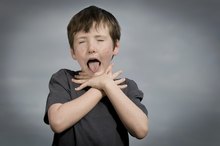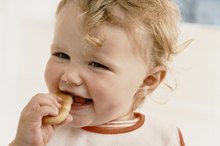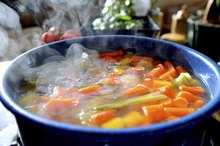Choking is the fourth leading cause of accidental death in children under age 5, according to the New York State Department of Health 4. The Consumer Product Safety Commissions reports that about 15 choking deaths are reported each year in kids younger than 3. Foods, toys, household items and basically anything that fits into your child's mouth are potential choking hazards. Becoming aware of some of the most common offenders can help keep your child out of harm's way.
Peanuts, Raw Veggies and Other Hard Foods
Peanuts, raw vegetables and other foods that need to be chewed with a grinding motion should be completely off limits to kids until after age 4, according to HealthyChildren.org, the official website of the American Academy of Pediatrics 1. Young children may try to swallow such foods whole since they don't typically master more sophisticated chewing abilities until around age 7. Popcorn, celery, hard candy, watermelon with seeds and raw apples are other examples of hard food that should be withheld until after age 4. Completely chopping or slicing hard foods like carrots can help prevent choking.
- Peanuts, raw vegetables and other foods that need to be chewed with a grinding motion should be completely off limits to kids until after age 4, according to HealthyChildren.org, the official website of the American Academy of Pediatrics 1.
Hot Dogs, Sausages, Cheese Cubes and Other Soft Food
Foods to Avoid for a Choking Prone Adult
Learn More
Hot dogs are the number one cause of food-related choking in kids under the age of 3. “Every food poses a choking risk in young kids but the hot dog has just the right size and consistency to perfectly block the airway, it’s the perfect plug that doesn’t allow any air to get through," explains Johns Hopkins Children’s pediatrician Nisha Kapadia, M.D. Sausages, cheese cubes and grapes can also cause choking in small children. Slicing them into tiny pieces and removing skin when needed can prevent choking.
- Hot dogs are the number one cause of food-related choking in kids under the age of 3.
- “ Every food poses a choking risk in young kids but the hot dog has just the right size and consistency to perfectly block the airway, it’s the perfect plug that doesn’t allow any air to get through," explains Johns Hopkins Children’s pediatrician Nisha Kapadia, M.D.
- Sausages, cheese cubes and grapes can also cause choking in small children.
Marbles, Balls, Balloons and Other Toys
Un-inflated and popped balloons are a leading cause of toy-related choking deaths, according to the Consumer Product Safety Commission. The AAP's HealthyChildren.org website agrees 1. Marbles and balls are also potentially hazardous to young children, especially little ones who try to put just about everything in their mouth. Toys with small parts and doll accessories like tiny shoes and jewelery can also pose a choking hazard. Always read age guidelines when selecting toys and teach older kids to keep their toys out of reach from younger siblings.
- Un-inflated and popped balloons are a leading cause of toy-related choking deaths, according to the Consumer Product Safety Commission.
Safety Pins, Coins and Other Household Objects
What Size Is Considered to Be a Choking Hazard?
Learn More
Safety pins, coins, button-type batteries, pen caps, nails, tacks and paper clips are common household items that are responsible for many choking incidents in young children. Make sure small objects are off the floor and safely out of reach of curious hands. Various kitchen items are also potential choking hazards. Bottle caps, especially sweet tasting ones like those on chocolate syrup and pancake syrup bottles may be be dangerous to little ones trying to lick the drops out of the caps. Refrigerator magnets. Children may also dig into the crash to retrieve egg shells and pop-tops from soda cans, which can pose choking dangers. The American Academy of Pediatrics specifically recommends that objects such as these be kept out of reach for young children under age 4, according to HealthyChilldren.org, AAP's official website.
- Safety pins, coins, button-type batteries, pen caps, nails, tacks and paper clips are common household items that are responsible for many choking incidents in young children.
- Children may also dig into the crash to retrieve egg shells and pop-tops from soda cans, which can pose choking dangers.
Related Articles
References
- HealthyChildren.org: Choking Prevention
- KIdsHealth.org: Preventing Choking
- John Hopkins Childrens Center: A Dangerously Tasty Treat...
- New York State Department of Health: Choking Prevention for Children
- Sidell DR, Kim IA, Coker TR, Moreno C, Shapiro NL. Food choking hazards in children. Int J Pediatr Otorhinolaryngol. 2013;77(12):1940-6. doi:10.1016/j.ijporl.2013.09.005
- Kramarow E, Warner M, Chen LH. Food-related choking deaths among the elderly. Inj Prev. 2014;20(3):200-3. doi:10.1136/injuryprev-2013-040795
- Ghasemi N, Razavi S, Nikzad E. Multiple Sclerosis: Pathogenesis, Symptoms, Diagnoses and Cell-Based Therapy. Cell J. 2017;19(1):1–10. doi:10.22074/cellj.2016.4867
- St Louis Children's Hospital. Why are Latex Balloons a Danger to Children? 2020.
- Walner D, Wei J. Preventing choking in children. AAP News. 2011; 32(4)16.
- CDC. Nonfatal Choking-Related Episodes for Children 0 to 14 years of Age. 2002.
- Committee on Injury, Violence, and Poison Prevention. Prevention of choking among children. Pediatrics. 2010;125(3):601-7. doi:10.1542/peds.2009-2862
- Kleinman ME, Brennan EE, Goldberger ZD, et al. Part 5: Adult Basic Life Support and Cardiopulmonary Resuscitation Quality: 2015 American Heart Association Guidelines Update for Cardiopulmonary Resuscitation and Emergency Cardiovascular Care. Circulation. 2015;132(18 Suppl 2):S414-35. doi:10.1161/CIR.0000000000000259
- American Academy of Otolaryngology – Head and Neck Surgery. (2011). Reducing Choking Risks: Tips for Early Education and Child Care Settings.
Resources
Writer Bio
Karen Hellesvig-Gaskell is a broadcast journalist who began writing professionally in 1980. Her writing focuses on parenting and health, and has appeared in “Spirituality & Health Magazine" and “Essential Wellness.” Hellesvig-Gaskell has worked with autistic children at the Fraser School in Minneapolis and as a child care assistant for toddlers and preschoolers at the International School of Minnesota, Eden Prairie.









